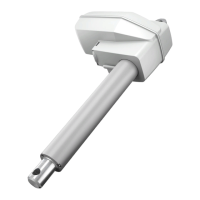Page 27 of 295
Warnings
• When using Li-Ion batteries with patient lift control boxes, loss of power might happen due to the battery deep discharge protection. This will only
happen in case of continuous battery use despite warnings. In this event, there may be no warning, and the application may not be able to move
when expected.
• In his risk analysis, the customer must take into consideration how to assure alternative means to make movement, for instance quick release or
manual lowering.
• Do not open the battery housing as damaging the cell or circuitry may develop excessive heat.
• If product caution is not clearly visible at low light intensity, read the product label instructions symbol. A warning must be included in the application
manufacturer manual for the medical device.
• The application manufacturer must test the application and ensure that intentional and unintended operations do not exceed the battery specification
limits.
• Defective or damaged Li-Ion batteries are not allowed for transportation.
• For safety reasons, please adhere to the indicated charging and operation temperature.
• In case the battery is too hot, disconnect it, evacuate the room, and wait for 2 hours before taking further steps.
• Mounting instructions must be followed in order to avoid exposing batteries to water.
• In general, recharging of battery must take place every 6 months. However, please note:
- New Li-Ion batteries, shipped from LINAK are in a deep-sleep state, where the self-discharge is very little.
- When mounted in an application, LINAK Li-Ion batteries wake up, resulting in a higher rate of discharge, depending on the application/system.
Application manufacturer must consider this idle consumption for his specific system and make precautions to avoid discharged batteries.
- Contact your LINAK sales team for further information.
• If batteries are to be shipped by air, they shall not be charged to more than 30%.
• Disposal of the battery takes place in accordance with local regulations.
Recommendations:
• Do not exceed the storage temperature as it will shorten the product life and performance.
• Allow the battery to settle to room temperature before use.
• Lithium ion batteries are not intended for use in outdoor applications and indoor pool environments.
• If the battery is completely discharged, then recharge the battery before storage.
• Always use correct LINAK
®
charger.
DO NOT:
• Heat or burn the batteries.
• Short circuit the batteries.
• Expose the batteries to high impact/excessive force.
• Crush or puncture the batteries.
• Use batteries with signs of damage or corrosion.
• Charge or store the batteries near combustible material.
• Exceed IP-ratings.
• Overcharge or fully discharge the batteries.
For detailed information on specific use of batteries, please see the product information in chapter 5.
Safety feature
Lithium ion batteries contain several mechanisms to protect themselves from being damaged due to excessive use. In case of overheating, the device
will activate a thermal protection. No power output will be available until the temperature is again within normal operating range.
Overheating may occur by extensive use at high temperatures or when exceeding the duty cycle. (see product label)
Batteries
Lithium ion batteries

